iPad mini Review
by Anand Lal Shimpi & Vivek Gowri on November 20, 2012 6:10 PM ESTDisplay Analysis
As with a discussion on performance in mobile devices these days, the iPad mini's display requires both an experiential analysis and an objective performance analysis. I'll begin with the experience.
Without a doubt, the iPad mini presents an evolution in form factor and nothing else. Everything from silicon to display technology are known quantities at this point. While it's true that in many senses, even Apple's previous generation mobile hardware is pretty good, the fact of the matter remains that the mini doesn't push the envelope in anything but form factor. That's not necessarily a bad thing, it's just reality. I should also point out that many smaller-versions-of-bigger-things follow this same approach of not pushing the performance envelope for obvious reasons.
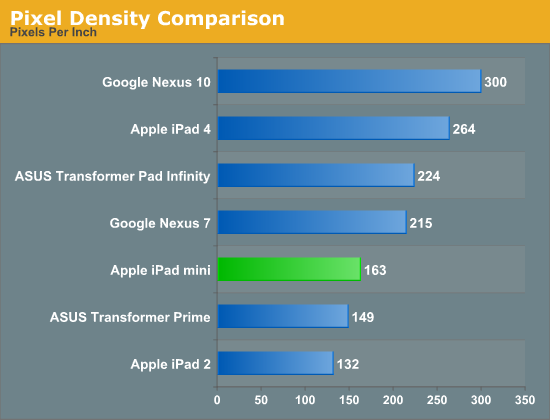
Doing the math on the mini's 1024 x 768 display results in a pixel density of 163 pixels per inch. A tangible improvement compared to the original iPad's 132 PPI, but keep in mind the smaller screen may have to be held closer to your eyes. Compared to other tablets, the mini's display resolution isn't anything to write home about. In practice, the mini's makes reading small text a problem:

While the 3rd and 4th gen iPads have a large enough display at a high enough resolution to make it possible to view the Dell configurator in the photo above without zooming, the same can't be said for the iPad mini. You're going to need a double tap.
Although reading text is one area where the absence of insane numbers of pixels is clearly obvious, it's visible in some photos as well.

iPad mini (left) vs. iPad 4 (right)
Where a lack of fine detail doesn't get you, the physical size of the display may. I was pleasantly surprised by the usefulness of Apple's 7.85-inch display, but given my early affinity towards 8-inch tablets it's not too shocking. Despite how useful the mini's display is, I found myself having to double tap to zoom in on most desktop websites just to make the reading a bit better. It's not that the process of zooming in on a website in mobile Safari is particularly cumbersome, it's that the fact that I have to makes me feel like I'm using more of an iPod Touch and less of an iPad. I do admit the feeling is quite irrational as I prefer keeping the iPod Touch (or iPhone in the case of, reality) holstered and using the mini instead. This is less a criticism of the iPad mini and more guidance for those deciding between mini and regular sizes of the iPad.
Compared to a true 7-inch tablet like the Nexus 7, the additional screen size is definitely appreciated - particularly when reading web pages:
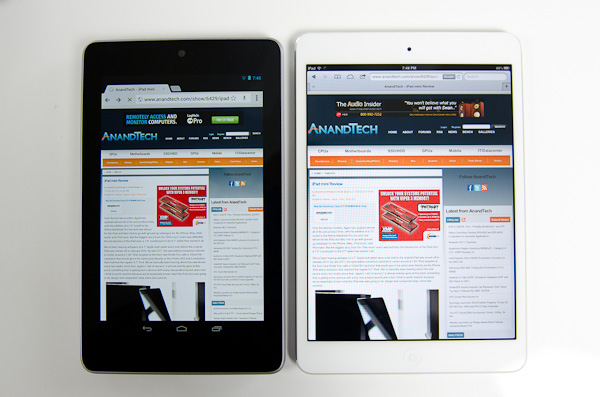
Nexus 7 (left) vs iPad mini (right)
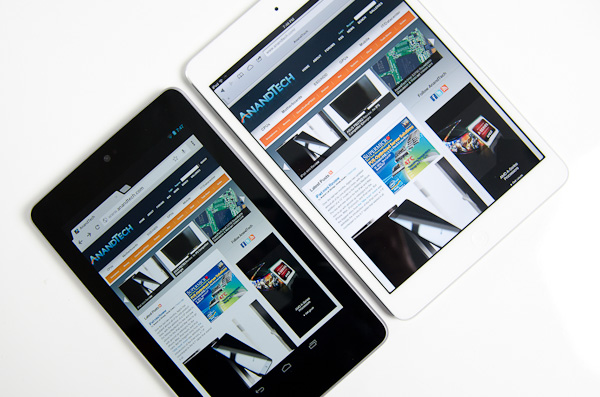
Nexus 7 (left) vs iPad mini (right)
When Vivek and I brought up the topic of the mini's lower pixel density on the Podcast, our own Brian Klug pointed out the obvious: we're spoiled. How impressed/unimpressed you are with the iPad mini's display really depends on what other displays you've been exposed to. In a vacuum, the iPad mini's display is fine. Brightness, black levels and contrast are all reasonable (and much better than most notebooks). Color reproduction isn't bad either. In the spectrum of all displays available at the mini's price point, this 7.85-inch 1024 x 768 panel isn't bad. Spend any appreciable time with the bigger iPad's Retina Display however, and your opinion will quickly change.


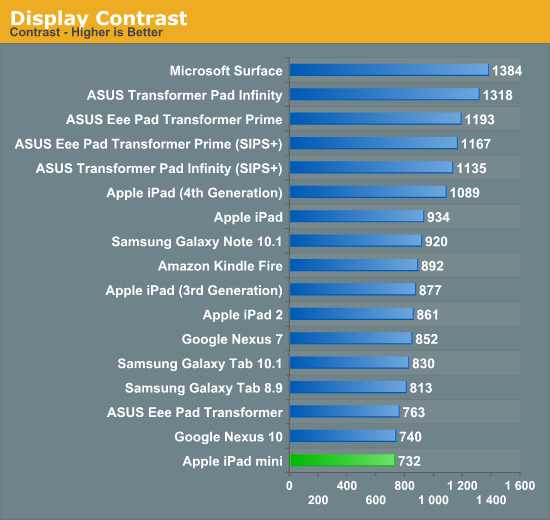
In our Surface review I titled the display section "Not Retina, But Still Good". Compared to the Surface display, the mini has better color accuracy but clearly loses out in black levels thanks to Microsoft's laminated display + cover glass stack.
To evaluate color accuracy I turned to our own Chris Heinonen's CalMAN smartphone/tablet workflow. We'll start off by looking at the calibrated white point for these tablets. What you're looking for here is a number close to 6500K:
The mini doesn't really diverge from other iPads here, although Microsoft comes closer to 6500K at 200 nits.
The next three charts look at accuracy represented as a difference between various source colors and what's reproduced on the display. The results are presented as average dE2000, with lower numbers being better.
First up is Grayscale performance, here we're looking at the accuracy of black, white and 19 shades of gray spread in between the two extremes:
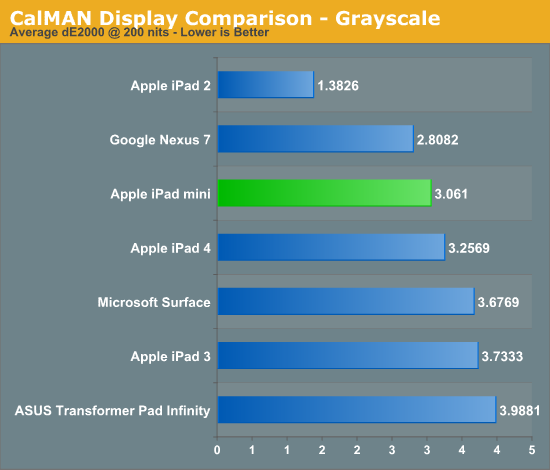
The mini does reasonably well here, it actually ends up a bit better than the 4th gen iPad. Grayscale accuracy doesn't seem to be too difficult for most folks to get right, but what happens when we start looking at colors?
First in our color accuracy tests is a saturation sweep. Here we're looking at 20%, 40%, 60%, 80% and 100% saturations of red, blue, green, magenta, yellow and cyan.
Now we start to see the retina equipped iPads pull away from the mini. Compared to the iPad 2 and even Microsoft's Surface, the mini looks pretty good, but if you compare it to the Nexus 7 or newer iPads it's clearly at a disadvantage. All of these displays are significantly better than the average notebook panel. As I mentioned earlier, it all boils down to perspective and expectations.
Gamut CIE Chart

Saturation CIE Chart

For our final accuracy test we're looking at the difference between a Gretag Macbeth colorchecker chart and the rendered swatches on these displays. Once again, lower numbers are better.
Once again, the iPad 3/4 can't be touched here, with the iPad mini falling significantly behind. Colors simply look better on the bigger iPads. The Nexus 7 does better here as well. Subjectively I found colors on the Nexus 7 to look appreciably more accurate than on the mini.
GMB Color Checker
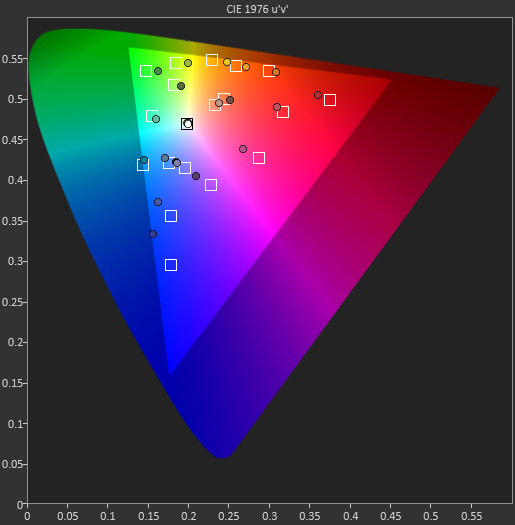
With regards to the quality and accuracy of the images rendered on the mini's screen, I feel the same way about it as I do the display on Surface: it's not a Retina display, but still good.


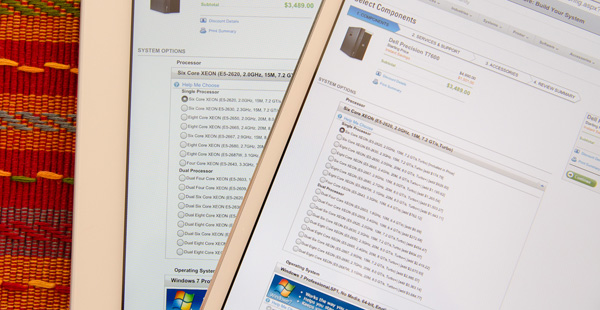
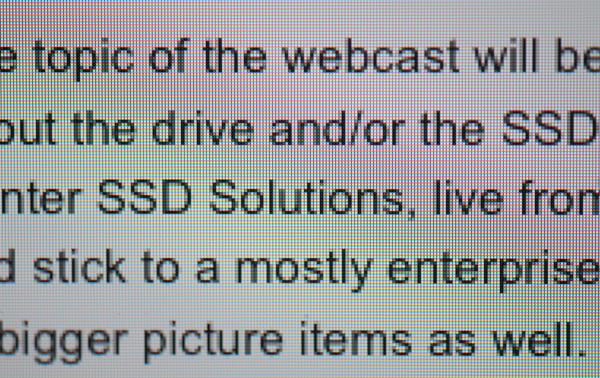
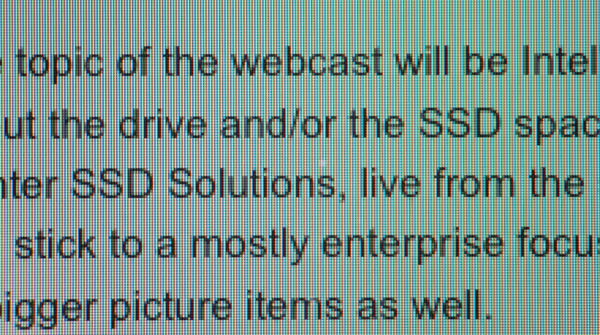
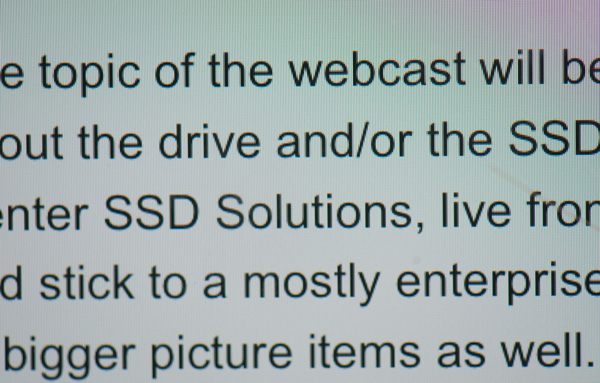
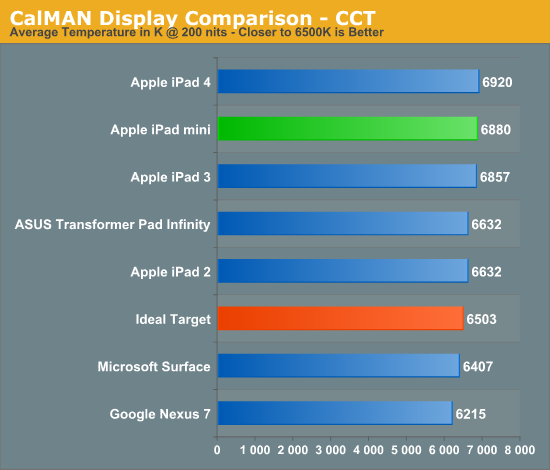
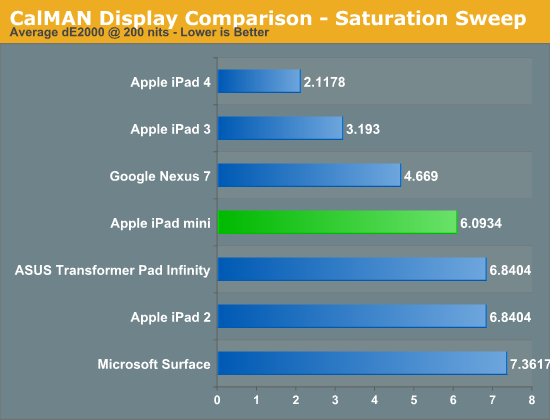
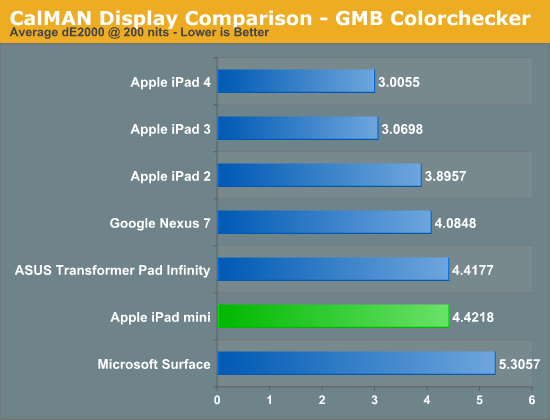








140 Comments
View All Comments
MadMan007 - Tuesday, November 20, 2012 - link
Here's another display-related thing to fix: the charts for Brightness (black and white) and contrast don't include the Nexus 7 for some bizarre reason..hmm...but the later charts on the same page 4 do.Anand Lal Shimpi - Tuesday, November 20, 2012 - link
Fixed, thank you :)Take care,
Anand
ksherman - Tuesday, November 20, 2012 - link
While I understand where you're coming from, the reason the Nexus is zoomed in is because the Nexus "fakes" it's resolution in the web browser to about 603 so that responsive web pages render elements larger so they're easier to use on the Nexus 7. So the side by side photo is simply comparing the default view on load.In fact, this is actually somewhat of a negative for the iPad Mini on responsive sites because it means it's rendering pages designed for a much larger display.
Source: http://www.lukew.com/ff/entry.asp?1663
MadMan007 - Wednesday, November 21, 2012 - link
Now this would be something interesting to investigate and inform readers about. I didn't know about different devices presenting different resolutions and am not sure what the differences really mean.Galatian - Tuesday, November 20, 2012 - link
As a medical student I fast pretty fast in preordering the cellular white iPad mini here in Germany. It is the perfect size to fit into a white coats pocket. I will read a lot of books on it, so it was a hard decision between this and the 4th Gen iPad. But size does matter and eventually Retina will come to the mini line. For right now I just have to live with the resolution.Granseth - Tuesday, November 20, 2012 - link
This is a big issue for me with the Ipad 2, and it will be the same with Ipad mini. When I try to use the Ipad2 as a productive device I often lose information I write because the webpages and apps has to reload when the device gets out of memory and have to free something to load the next app/webpage. And this has become much worse as the Ipad has aged, so it's terrible that they are selling a new device with only 512MB of RAM.But hopefully people will use this smaller device as a consumption device, and not a productivity device.
ratte - Tuesday, November 20, 2012 - link
Excellent review as always, balanced and informative.It's a pity that Apple can't easily go to an intermediate resolution like 1600 x 1200, like Android can, but is stuck with the rezdoubling. For me the mini would have felt more futureproof if they had used an A6 with 1Gb memory. but then this is Apple....
MadMan007 - Tuesday, November 20, 2012 - link
Yeah, they need something obvious but AWESOME to make sure everyone buys a new one next year.Gaugamela - Tuesday, November 20, 2012 - link
Now it's easy to understand why Apple wanted to ban the Galaxy Tab 7.7. The iPad Mini is a rip-off of it. With a much worse display since the GT7.7 had a Super Amoled + display of superior resolution.Samsung was a year ahead of Apple and it still holds up great, if Samsung updated it to Jelly Bean.
I would like to see a new Galaxy Tab 7.7.
And the display is a disapointment. It makes it a no buy device instantly, it's 130$ more expensive than the Nexus 7 and offers a worse display. Anyone that picks the Mini should only do it by the form factor or preference by iOS.
ltcommanderdata - Tuesday, November 20, 2012 - link
The form factor is why I'm considering the iPad Mini over the Nexus 7. It has great build quality, is thinner, lighter, yet has battery life that is similar or better and has a screen that's a third larger. The Nexus 7's advantage in screen resolution in itself is not as important for me because the screen is smaller so showing more tiny content isn't useful. The lower pixel density is a concern for clarity. The CPU may be weaker, but the GPU is stronger which given good GPU acceleration for UI responsiveness is a reasonable exchange. $130 more maybe worth it if the better form factor makes the device more useable so that it sees more use.